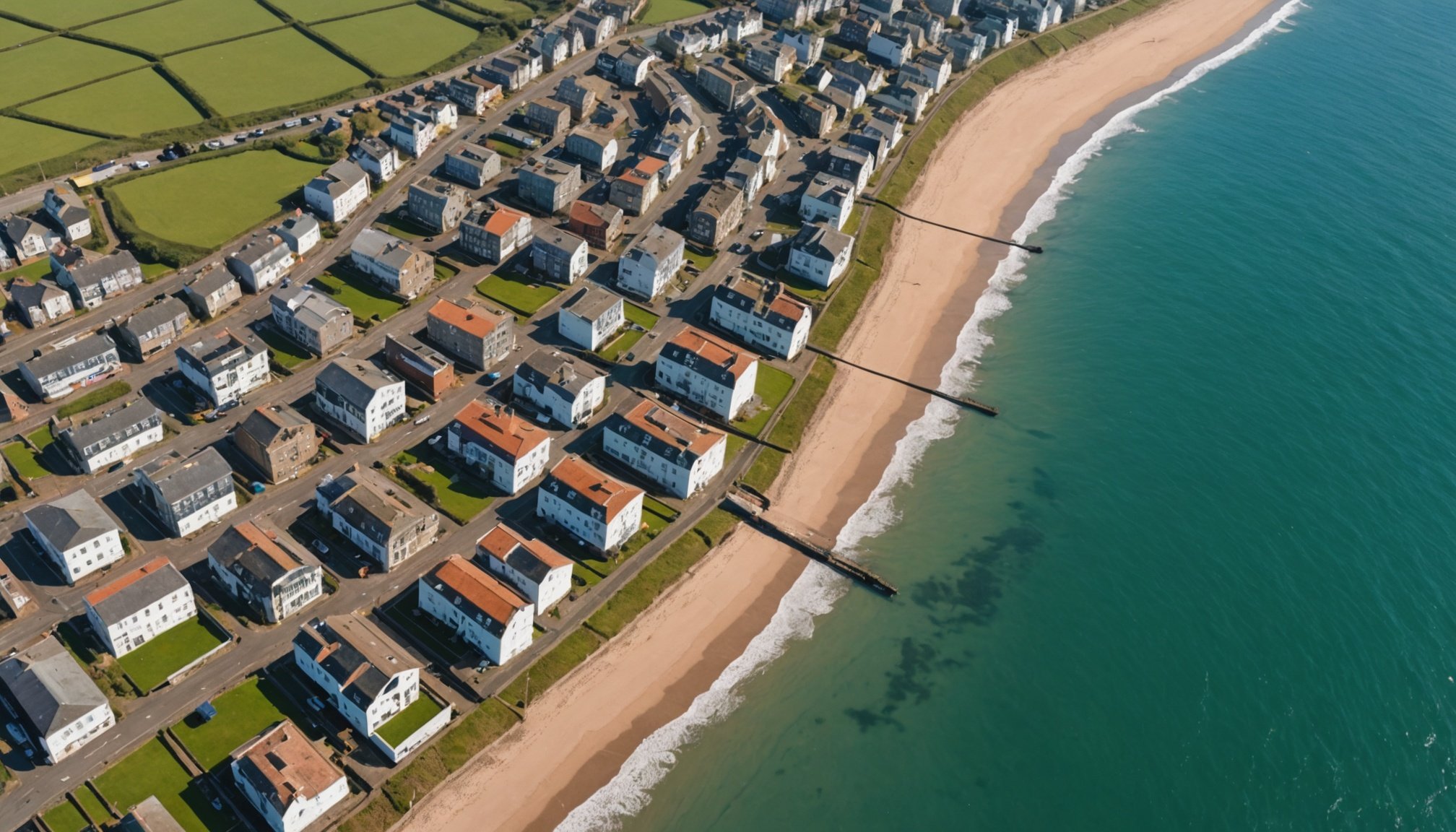Overview of Climate Change Impacts on Coastal Areas
Climate change has profound effects on coastal areas, resulting in significant environmental impacts. One of the primary consequences is the detrimental effect on coastal ecosystems. Rising sea levels, a direct outcome of climate change, threaten delicate habitats and biodiversity. Species struggle to adapt to shifting conditions, which disrupts ecological balance.
Additionally, the rise in sea levels poses serious implications for real estate in coastal regions. As water encroaches on land, valuable properties face erosion and flooding, affecting their market value and desirability. This leads to increased insurance costs and a potential decline in investment appeal.
Also read : Smart solutions for uk landlords: enhancing property management during tenant transitions
An alarming impact of climate change in these areas is the increased frequency of extreme weather events. Storms and hurricanes are becoming more intense, causing severe damage to infrastructure and landscapes. The unpredictability of these events makes future planning and risk management challenging for residents and local governments.
Understanding these issues is crucial for developing strategies to mitigate impacts and safeguard both natural ecosystems and human investments in coastal regions. Comprehensive planning, incorporating climate predictions and robust infrastructure solutions, is essential to enhance the resilience of coastal areas against the changing environment.
Also to see : Empowering uk landlords: revolutionary property management software to harness new opportunities
Current State of Coastal Real Estate in the UK
The UK property market faces unique challenges and opportunities when it comes to coastal real estate. Investment trends in coastal areas have fluctuated, influenced by emerging climate risks and shifting buyer preferences. Despite potential risks, some investors see opportunity in properties that offer scenic views and a lifestyle close to nature.
In recent years, case studies highlight variations in coastal property sales. For instance, properties in less vulnerable areas, with robust flood defenses, retain their appeal. Contrarily, properties in high-risk zones experience declining values due to erosion and potential flooding threats.
Economic factors further shape coastal market performance. While increased insurance costs deter some buyers, others are drawn by lower initial property prices. These dynamics illustrate the complex interplay between environmental risks and market factors in determining property value.
Astute investors focus on areas with active climate resilience measures, viewing them as more secure long-term assets. As awareness of climate impacts grows, the need to assess these elements becomes critical for making informed investment decisions in the UK coastal real estate market.
Legislative and Regulatory Framework
Navigating the regulations for coastal properties in the UK can seem daunting. However, understanding the government policies that shape coastal real estate can inform more strategic investment decisions. The UK legislative landscape significantly influences how coastal developments are managed. Planning regulations for such developments are crucial to ensure sustainability and resilience against climate events. They dictate where and how new properties can be built, considering the risks posed by climate change.
To encourage compliance, the government provides incentives and funding for projects that enhance climate resilience. These can include grants for enhancing protective infrastructure like sea walls or funding for research into sustainable development practices. Such measures are essential to support communities and ecosystems in vulnerable coastal areas.
Moreover, understanding these policies allows investors and developers to align with governmental priorities, potentially availing of financial assistance while future-proofing their investments. Being proactive in addressing climate impacts not only protects property values but also plays a vital role in safeguarding the environment. Recognising and capitalising on these legislative opportunities is key for any investor interested in coastal property.
Risk Assessment and Property Value Implications
In the ever-changing landscape of coastal properties, understanding risk assessment is essential for safeguarding investments. Recognising the investment risks posed by climate change enables more effective strategic planning. Evaluating climate-related risks involves analysing both current and projected environmental conditions. Experts often use historical data to predict property market fluctuations due to climate events. These assessments help determine how vulnerable a property may be to rising sea levels, storms, and erosion.
Property values are significantly impacted by climate-induced changes. Properties located in high-risk zones tend to see a decline in value, as potential buyers factor in the costs of insurance, maintenance, and repairs. Conversely, well-protected areas with climate resilience measures may maintain or even increase in value. Investors should pay close attention to local government efforts to combat climate change impacts through infrastructure improvements, as these can bolster property values.
By prioritising detailed risk assessments, investors can better anticipate future trends in property values. They should consider climate resilience measures as a key component of their investment strategy to minimise losses and enhance potential returns. Such proactive planning is crucial for navigating the complexities of the coastal real estate market.
Strategic Investment Advice for Coastal Properties
Investing in coastal properties presents unique opportunities and challenges. To ensure profitable outcomes, adopting effective investment strategies is crucial. These strategies should consider both current market insights and future trends. Begin with diligent research on properties equipped with climate resilience measures, as they are more likely to sustain their value.
Market insights reveal that properties in areas with robust local government climate policies and protective infrastructure are attractive options. Investors should evaluate potential investment strategies that mitigate climate risks, such as coastal protection measures and environmental certifications.
Moreover, consider long-term investments that benefit from scenic and lifestyle appeal without forgoing safety. Experienced investors recommend a diversified portfolio spread across locations with varying levels of climate risk.
When evaluating a property’s potential, assess proximity to safe zones and ecosystems likely to withstand rising sea levels. This ensures sustainability and better returns.
Investors should remain abreast of technological innovations that can enhance property resilience and adapt to climate impacts. By aligning investment strategies with these innovative solutions, enhancing both property security and market appeal is possible. Employ sound judgement, guided by comprehensive market insights, to navigate the complexities of coastal real estate effectively.
Case Studies and Best Practices
Examining case studies in coastal real estate sheds light on what constitutes a successful investment. One notable example is a seaside development in southern England, which incorporated extensive flood defenses. By prioritising infrastructure resilience, this project saw appreciation in property values despite rising sea levels.
Conversely, failed investments provide valuable lessons. Properties built in high-risk areas without protective measures have faced depreciation, spotlighting the importance of environmental assessments before purchasing. Learning from such missteps helps investors avoid repeating them.
Best practices in coastal investment include:
- Prioritising resilient locations over solely scenic ones.
- Investing in properties that align with local climate mitigation policies.
- Conducting thorough risk assessments that account for future climate predictions.
Investors successful in coastal real estate routinely integrate these elements into their strategy. By optimising investment strategies to include climate considerations, they ensure not only financial gains but also contribute to sustainable development practices. Insight from past projects, both successful and otherwise, is invaluable for navigating the uncertain waters of coastal investments. Adhering to these practices promises more stable returns and secures the interests of investors long term.
Future Outlook for Coastal Real Estate in the UK
The future trends in UK coastal real estate suggest that adaptation will become a central theme for investors and developers by 2030. As the impacts of climate change intensify, climate adaptation strategies are crucial to maintain property value and appeal. Investors are increasingly seeking adaptation strategies such as elevating buildings and constructing resilient infrastructure to protect against flooding and erosion.
Being proactive is essential; investors and developers are turning to technology to enhance property resilience. Technological solutions, such as advanced flood detection systems and sustainable building materials, offer newfound adaptation strategies. These innovations not only safeguard investments but also align with broader climate adaptation initiatives, promoting sustainable development.
Future trends also highlight a growing focus on eco-friendly developments. Properties that incorporate renewable energy sources and water conservation measures appeal to environmentally conscious buyers. These features are becoming pivotal as future trends indicate rising consumer demand for sustainable housing options.
In conclusion, the UK’s coastal real estate market must embrace and integrate adaptation strategies to thrive amidst climate challenges. The role of technology and sustainability is increasingly vital, shaping the future of coastal investments and potentially securing long-term growth and stability.










